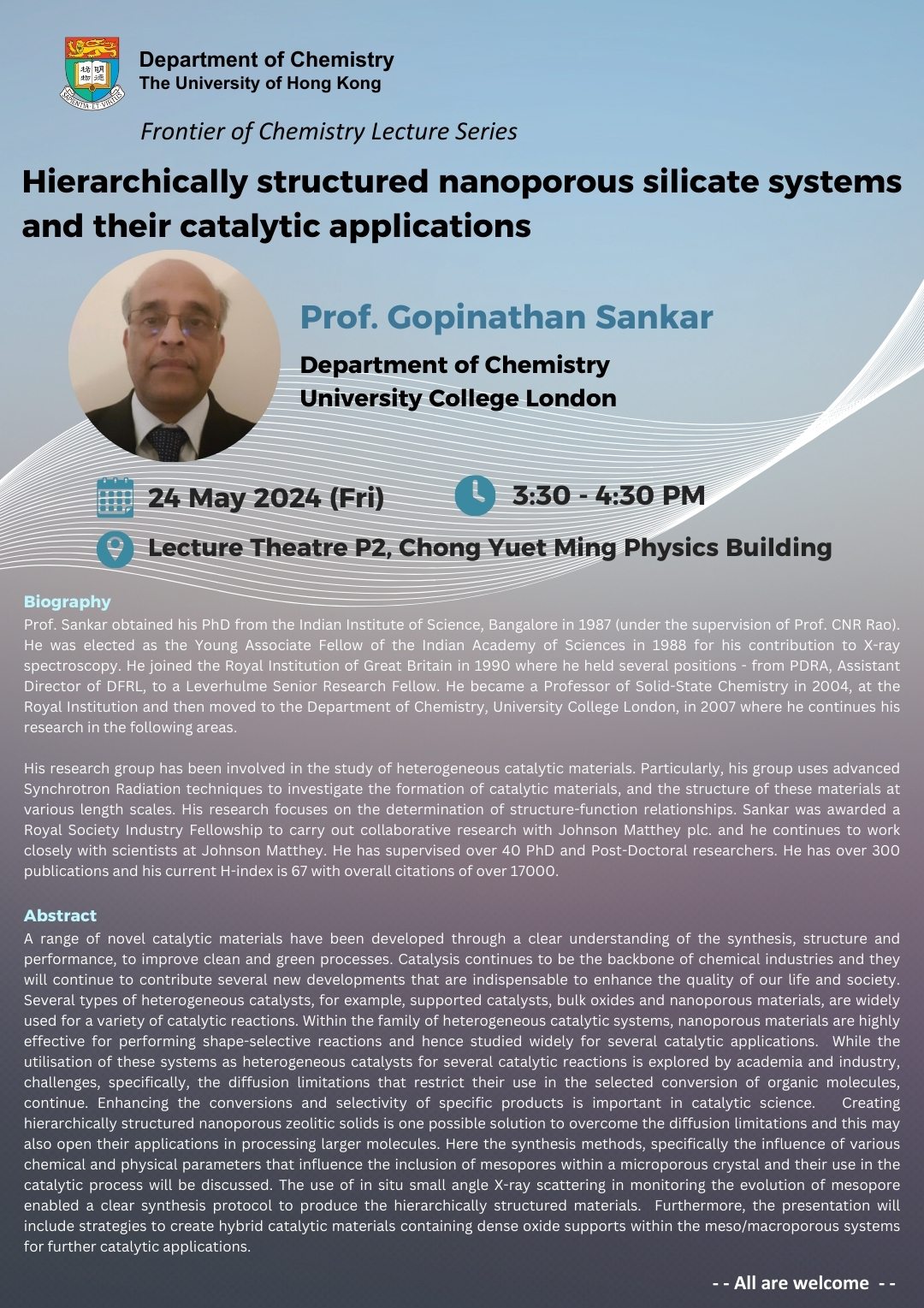| Date | 24 May 2024 |
| Time | 3:30 pm - 4:30 pm (HKT) |
| Venue | Lecture Theatre P2, Chong Yuet Ming Physics Building |
| Speaker | Prof. Gopinathan Sankar |
| Institution | Department of Chemistry, University College London |

Title:
Hierarchically structured nanoporous silicate systems and their catalytic applications
Schedule:
Date: 24th May, 2024 (Friday)
Time: 3:30 - 4:30 pm (HKT)
Venue: Lecture Theatre P2, Chong Yuet Ming Physics Building
Speaker:
Biography:
Prof. Sankar obtained his PhD from the Indian Institute of Science, Bangalore in 1987 (under the supervision of Prof. CNR Rao). He was elected as the Young Associate Fellow of the Indian Academy of Sciences in 1988 for his contribution to X-ray spectroscopy. He joined the Royal Institution of Great Britain in 1990 where he held several positions - from PDRA, Assistant Director of DFRL, to a Leverhulme Senior Research Fellow. He became a Professor of Solid-State Chemistry in 2004, at the Royal Institution and then moved to the Department of Chemistry, University College London, in 2007 where he continues his research in the following areas.
His research group has been involved in the study of heterogeneous catalytic materials. Particularly, his group uses advanced Synchrotron Radiation techniques to investigate the formation of catalytic materials, and the structure of these materials at various length scales. His research focuses on the determination of structure-function relationships. Sankar was awarded a Royal Society Industry Fellowship to carry out collaborative research with Johnson Matthey plc. and he continues to work closely with scientists at Johnson Matthey. He has supervised over 40 PhD and Post-Doctoral researchers. He has over 300 publications and his current H-index is 67 with overall citations of over 17000.
Abstract:
A range of novel catalytic materials have been developed through a clear understanding of the synthesis, structure and performance, to improve clean and green processes. Catalysis continues to be the backbone of chemical industries and they will continue to contribute several new developments that are indispensable to enhance the quality of our life and society. Several types of heterogeneous catalysts, for example, supported catalysts, bulk oxides and nanoporous materials, are widely used for a variety of catalytic reactions. Within the family of heterogeneous catalytic systems, nanoporous materials are highly effective for performing shape-selective reactions and hence studied widely for several catalytic applications. While the utilisation of these systems as heterogeneous catalysts for several catalytic reactions is explored by academia and industry, challenges, specifically, the diffusion limitations that restrict their use in the selected conversion of organic molecules, continue. Enhancing the conversions and selectivity of specific products is important in catalytic science. Creating hierarchically structured nanoporous zeolitic solids is one possible solution to overcome the diffusion limitations and this may also open their applications in processing larger molecules. Here the synthesis methods, specifically the influence of various chemical and physical parameters that influence the inclusion of mesopores within a microporous crystal and their use in the catalytic process will be discussed. The use of in situ small angle X-ray scattering in monitoring the evolution of mesopore enabled a clear synthesis protocol to produce the hierarchically structured materials. Furthermore, the presentation will include strategies to create hybrid catalytic materials containing dense oxide supports within the meso/macroporous systems for further catalytic applications.
- ALL ARE WELCOME -
